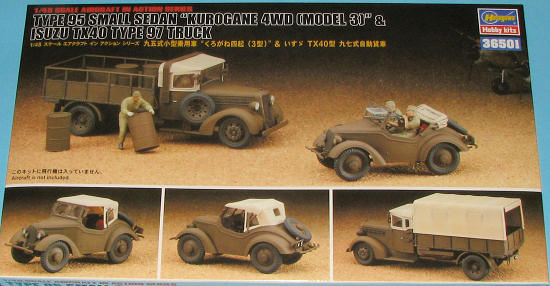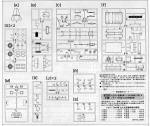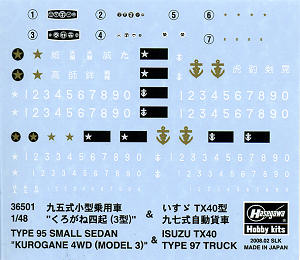
Hasegawa 1/48 Type 95 small sedan and type 97 truck
| KIT: | Hasegawa 1/48 Type 95 small sedan and type 97 truck |
| KIT #: | 36501 |
| PRICE: | $ |
| DECALS: | Yes |
| REVIEWER: | Scott Van Aken |
| NOTES: |

| HISTORY |
| The Type 95 Scout Car had its origins due to the passage of the Military Automobile Subsidy Act, which officially established the Japanese automobile industry in 1928. Japan’s annual production began at 460 vehicles but grew to 43,551 by 1940. The Type 95 was a lightweight 4x4 reconnaissance vehicle that was developed after the Manchurian incident which demonstrated to the Japanese Army the need for such a vehicle. The Type 95 was built by Kurogane and was the Japanese army’s only totally native designed vehicle of its type. Most of the others were derived from American designs. This car (and it was a car, unlike the Jeep which was basically a small truck) was first manufactured in 1937 and was the most widely used machine of its type by Japanese forces on all fronts during World War II. There were a variety of body types and the total number produced was around 4,800. This was the “Jeep” for the Japanese army and was nicknamed ‘Black Medal’. |
| The vehicle was powered by a 4-stroke, 2-cylinder V-I-A-F 1399-cc air-cooled gasoline engine. It could develop 33 bhp. The air-cooled engine was ideal for the cool climates it was required to work in such as Manchuria and northern China. Its three speed transmission (three forward, one reverse) was able to pull the 2300 pound car at what had to be a sedate clip, especially if fully loaded with its maximum of four passengers. The TX 40 truck was as ubiquitous for Japan as the Opel Blitz was for the Germans or the GMC for the US. The truck was designed by Isuzu but produced as much by Kawasaki heavy industries as anyone else. First rolling of the assembly line in late 1938, the truck soon reached a production of 1,500 units annually. A pittance compared to US production, but not bad by the Japanese standards of the time. This basic chassis was used for a wide variety of services as one would expect for what was basically a 2 1/2 ton truck. Like trucks in other ex-Axis countries, the Type 97 was produced post war and helped get Japan back onto her feet. |
| THE KIT |
 Hasegawa is slow
Hasegawa is slow ly getting involved in 1/48 vehicles and has chosen some pretty interesting subjects so far. First was the BMW 327 and now this pair. The kit includes two vehicles with 'crew' and it appears that perhaps these will be either marketed separately or included with other kits as there are two complete sets of instructions.
ly getting involved in 1/48 vehicles and has chosen some pretty interesting subjects so far. First was the BMW 327 and now this pair. The kit includes two vehicles with 'crew' and it appears that perhaps these will be either marketed separately or included with other kits as there are two complete sets of instructions.
Both kits have all their respective pieces in one polybag which doesn't help keep sprues from becoming entangled during shipment and deforming or breaking parts. This may not be a problem in Japan, but it certainly is with all the handling that goes on during international shipment.
Parts are superbly molded and show only a teeny bit of flash on a couple of bits. There are the usual ejector pin marks on the underside of the chassis, inside wheels and fenders and on other parts. Most of these can be made invisible for the most part by judicious placement and gluing the models to the base where dental mirrors and flashlights can't get under the vehicles.
As we have come to expect from Hasegawa, the parts count for these kits is relatively high. Where some companies will combine a number of parts into one, Hasegawa has all of these separate. It does make for a more detailed product at the expense of ease of construction. I've shown the actual parts for the 4WD sedan and the sprue guide for the truck so that you aren't just looking at a mass of plastic.
 Both kits come with optional tops that are molded in clear plastic so you don't have to fiddle with installing any clear bits into them later. The tops can be positioned either up or down as the need arises. For the sedan, though listed as four passenger, this one only has a single rear seat that is positioned between the two front ones. There is also an option to install an infantry rifle on a swivel mount for the passenger. The truck has a number of fuel or oil barrels that can be placed in the back of the truck if one wants to.
Both kits come with optional tops that are molded in clear plastic so you don't have to fiddle with installing any clear bits into them later. The tops can be positioned either up or down as the need arises. For the sedan, though listed as four passenger, this one only has a single rear seat that is positioned between the two front ones. There is also an option to install an infantry rifle on a swivel mount for the passenger. The truck has a number of fuel or oil barrels that can be placed in the back of the truck if one wants to.
Instructions are well done with the usual Gunze references. Markings options for both are limited to one for the Army or Navy as the case may be. Both are painted in colors that have to be mixed to provide the appropriate shades. I'm sure that somewhere along the line a dedicated Japanese vehicle color will be developed. A there are no anchors on the box art vehicles, then I have to assume that these are Army . The decal sheet provides both instrument panels and a variety of numbers to be used on the license plates as well as some decals for the figure.
| CONCLUSIONS |
I am quite pleased to see these being produced. When one includes the fuel truck that comes with the Ki-45 then that makes three Japanese military vehicles we can now use for our 1/48 dioramas. As these were also captured by the Allies, then that adds even more possibilities to things. These are sure to find favor with diorama fans and those of us who like things a bit different.
| REFERENCES |
My thanks to www.dragonmodelsusa.com for the review kit. Get yours today and your local shop or have them order it for you.
April 2008
If you would like your product reviewed fairly and fairly quickly, please contact the editor or see other details in the Note to Contributors.